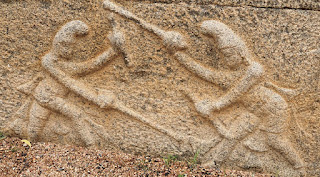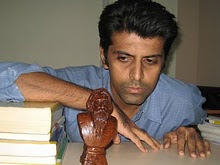Hampi - a brief revisit
Back in 2015, I visited Hampi and spent 4 full days tramping all around the place. And last month, I was back, briefly. The place has changed somewhat. Considerably more pilgrims seem to visit the Virupaksha temple these days. More seriously, all the many 'guest houses' in the village - functional, convenient and at least during off-season, very reasonably priced - have been forced to shut down by some weird court order and one has to look for acco in the filthy village of Kamalapuram 3 km away or the chaotic town of Hospet, an inconvenient 15 kms distant. However, the relics of the once mighty Vijayanagar capital remain what they have always been for centuries - densely atmospheric. Here is a short visual essay that focuses only on curious details:
A 'kinnari' musician on one of the temple pillars.
Very muslim arches in the 'Queen's bath':
Scalloped arches from the Lotus Mahal. They look very Shah Jahani - and predate the Mughal by a century and more!
Creepers overflowing a flower-pot - or stylized smoke from an incense burner. The first time I noticed this much loved motif was among the mosques at Champaner Pavgad in distant Gujarat a decade and more ago.
Dancers and musicians - their costumes look very like modern Bharatanatyam - from the Mahanavami Dibba:
A duel (?) featuring two figures wielding weird-looking weapons and sporting what look like Phrygian caps:
One of the kilometers of still standing massive walls. Neat granite slabs and blocks outside, rubble inside. Were they always like this or are the outer slabs a modern restoration effort?
A langur sits very still in driving rain as the gopuram of the Virupaksha temple looms:
Yet another of the many strange pillar figures at the Achyuta Raya temple:
A whole host of carvings - Kannappa, Vyaghrapada(?), Bheema(?), a fish-rider,...
And I also saw a particularly shocking carving of a female figure performing an essential act of ablution. No picture!
A 'kinnari' musician on one of the temple pillars.
Very muslim arches in the 'Queen's bath':
Scalloped arches from the Lotus Mahal. They look very Shah Jahani - and predate the Mughal by a century and more!
Creepers overflowing a flower-pot - or stylized smoke from an incense burner. The first time I noticed this much loved motif was among the mosques at Champaner Pavgad in distant Gujarat a decade and more ago.
Dancers and musicians - their costumes look very like modern Bharatanatyam - from the Mahanavami Dibba:
A duel (?) featuring two figures wielding weird-looking weapons and sporting what look like Phrygian caps:
One of the kilometers of still standing massive walls. Neat granite slabs and blocks outside, rubble inside. Were they always like this or are the outer slabs a modern restoration effort?
A langur sits very still in driving rain as the gopuram of the Virupaksha temple looms:
Yet another of the many strange pillar figures at the Achyuta Raya temple:
A whole host of carvings - Kannappa, Vyaghrapada(?), Bheema(?), a fish-rider,...
And I also saw a particularly shocking carving of a female figure performing an essential act of ablution. No picture!






















